Heating systems for non-residential and residential premises are presented on the market in large numbers. And among all this variety, the film infrared heater stands out for its high efficiency, long service life and increased operational safety.
The article presented by us describes in detail the principle of operation of the equipment used to form radiant heating. The advantages and disadvantages are listed, technical characteristics are given. We will introduce you to the applications and methods of constructing popular film systems.
The content of the article:
-
Electrical appliances for infrared heating
- Advantages of the infrared principle
- The device of the film heating system
- Scope of infrared PLEN
- Characteristics and types of IR films
- Advantages and disadvantages of film heaters
-
Features of installation of film infrared heating
- Option #1 - on the floor
- Option #2 - on the ceiling
- Conclusions and useful video on the topic
Electrical appliances for infrared heating
Abbreviation PLEN means "film radiant electric heater" or simply "film electric heater". It is permissible to use a heating IR film as both an additional and a main heat source.
In fact, this is a film with internal heating elements that emit infrared waves as a result of the passage of an electric current through them.
Advantages of the infrared principle
The heating of the air masses in the room from one or another source can be carried out due to:
- thermal conductivity;
- convection;
- thermal radiation.
The first two principles of heat transfer are used in water and oil coolers, as well as fans with heating coils.
In them, first with the help of a coolant or heating element a certain working surface is heated, from which the room air is then heated in its immediate vicinity. Then, with the help of natural or forced convection, air is exchanged throughout the room.
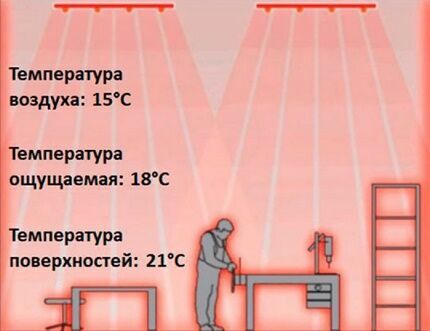
Film infrared heaters are heating systems that do not directly heat the air in the room, but first the surfaces of the walls, furniture, floor and ceiling in it
Thermal radiation means the transfer of heat from a source using electromagnetic radiation in the infrared spectrum. The air cannot be heated directly from infrared rays.
They are able to heat only surfaces made of solid materials. That is, first as a result of work heating systems PLEN furniture and decoration in the room are heated, and then they give off heat to the air.
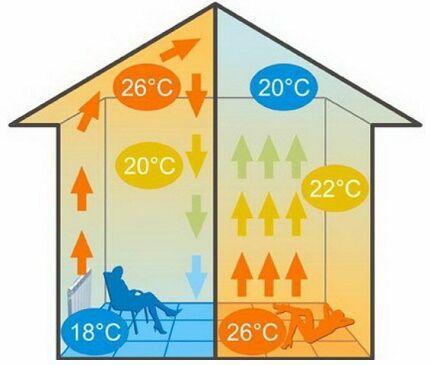
IR rays are often referred to as "thermal radiation" because the effect of infrared equipment is perceived tactilely by a person as a feeling of warmth and does not cause any discomfort.
Infrared heat is electromagnetic waves in the range of 0.74-2000 microns. If you look at the Sun, then about 40% of its radiation to the Earth comes from visible light, and about 10% and 50%, respectively, from UV and IR rays.
Film electric heaters of the IR type generate thermal energyhaving a wavelength in the region of 9.2 microns. For a person, such rays are completely safe, natural, since they most of all resemble “sunshine”. After all, the human body itself radiates heat in the infrared spectrum with a wavelength of 9.6 microns.
The device of the film heating system
IR film electric heaters include three main elements:
- heating;
- transmitting;
- radiate.
The first converts electrical energy into heat. The second distributes the generated heat over the entire area PLEN, and the third emits infrared rays.
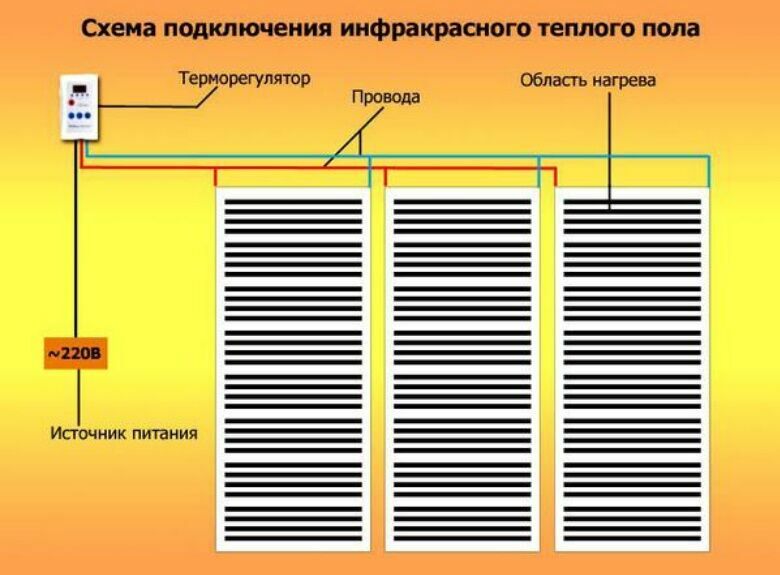
In addition to the heating IR film, the film heating system also includes a thermostat with one or more temperature sensors and cables for connecting the heater to the mains
heating element in PLEN made of high resistance conductor. Usually this is a thin strip of nichrome (spirals are made from it in heating elements) or carbon. At the same time, almost all manufacturers of IR film heaters have now switched to the second option. Carbon fiber is more economical, cheaper and more efficient.
The transmission element is a layer of aluminum foil, which has a high thermal conductivity. It is located on one or both sides of the IR film. Also, a number of manufacturers do not use aluminum at all, relying only on the radiating material.
The upper layer of the considered film heater on both sides is made of PAT (polyethylene terephthalate). film from this thermoplastic has a high coefficient of IR radiation, calmly withstands temperatures up to +2000C and is an excellent dielectric.
The film cleans the internal heating elements from condensate and moisture, forms a single heating system from disparate components, and also reduces the risk of electric shock to a person almost to zero.
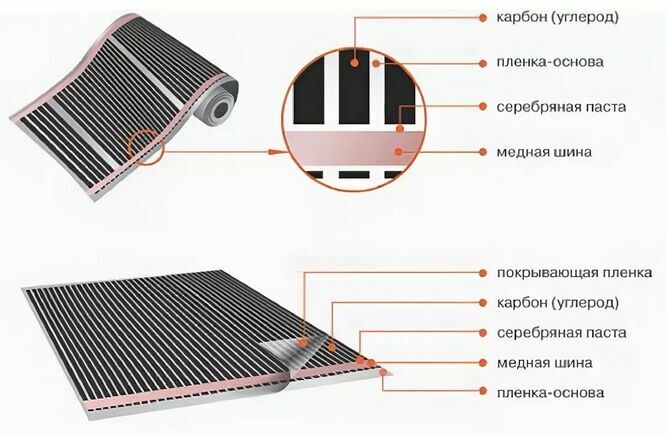
The IR film is designed so that the heating elements inside it can only heat up to +55º C. Temperatures above are practically excluded, such heating is possible only for a short time in an emergency with a sharp power surge in the network
The calculation and installation of the film IR heater are made taking into account that the film will work for heating not constantly, but in short intervals from several seconds to several minutes.
That is, such an infrared heater quickly raises the temperature of the surfaces in the room to the required values, and then turns off the thermostat. And then again powered from the mains only from time to time as the room air cools.
Scope of infrared PLEN
Film radiant electric heaters are most often used as an add-on to water heating. In the southern regions, they can serve as the main heating system. It is only necessary to correctly calculate the area of the infrared film needed for the required situation.
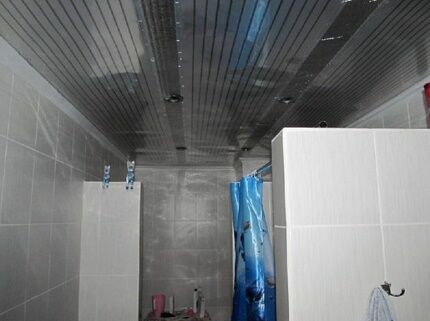
With the help of a film IR heater, you can heat the floor completely or in zones. It is installed on the ceiling and attic slopes, walls in ordinary residential premises and even baths, because. films with IP 54 calmly tolerate high humidity
Infrared film heaters can be installed in:
- residential country houses;
- city apartments;
- baths and saunas;
- production and storage facilities;
- yards for keeping animals;
- garages with and without heating;
- greenhouses, etc.
There are no fundamental restrictions for the use of the considered low-temperature electric heaters. The only limitation for the device infrared heating - the room should be with dimensions up to 3 meters in height. If the ceilings are higher, then you will need to install high-temperature and more expensive models of infrared heaters.
Characteristics and types of IR films
Infrared electric heaters are divided into two types - low temperature and high temperature. The first are able to heat up only up to +50 0C, and the second even up to 200 0FROM. In everyday life, only variants of the first type are used in the form PLEN or lamp or panel devices designed to operate from a 220 V electrical network.
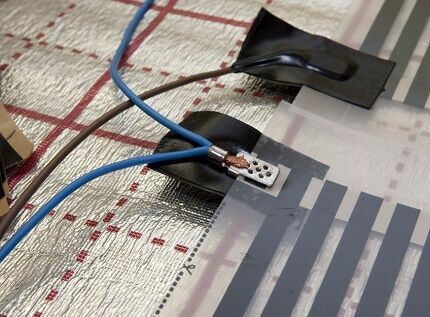
The thickness of the IR films themselves does not exceed 1 mm, but there are also metal terminals for connecting them to the wiring, which are somewhat thicker
Technical characteristics of low-temperature film IR heaters are as follows:
- Rated voltage - 220 Volts.
- The maximum film heating temperature is 40–550C depending on model and manufacturer.
- Degree of protection according to IP - from "22" to "67".
- The weight of the heating cloth is about 500 grams/m2.
- Specific power – 150–300 W/m2.
- Current load - 0.68–1.4 A / m2.
- Length - 0.25–7 m.
- Width - 0.5–1 m.
Manufacturers give a guarantee for infrared film for 10-15 years. However, in fact, such heating systems serve up to half a century.
According to the method of installation, film IR heaters are divided into:
- wall-mounted - "warming pictures" (for additional local heating);
- ceiling - for stretch and suspended ceilings;
- floor - "warm floor".
The floor analogue in terms of efficiency is slightly inferior to the ceiling. Film floor heating can not be laid under cabinets, beds and sofas. And the furniture of the place in the living room always takes up a lot of space. "Pictures" and just films behind the decor on the wall are the worst way to use IR film heaters.
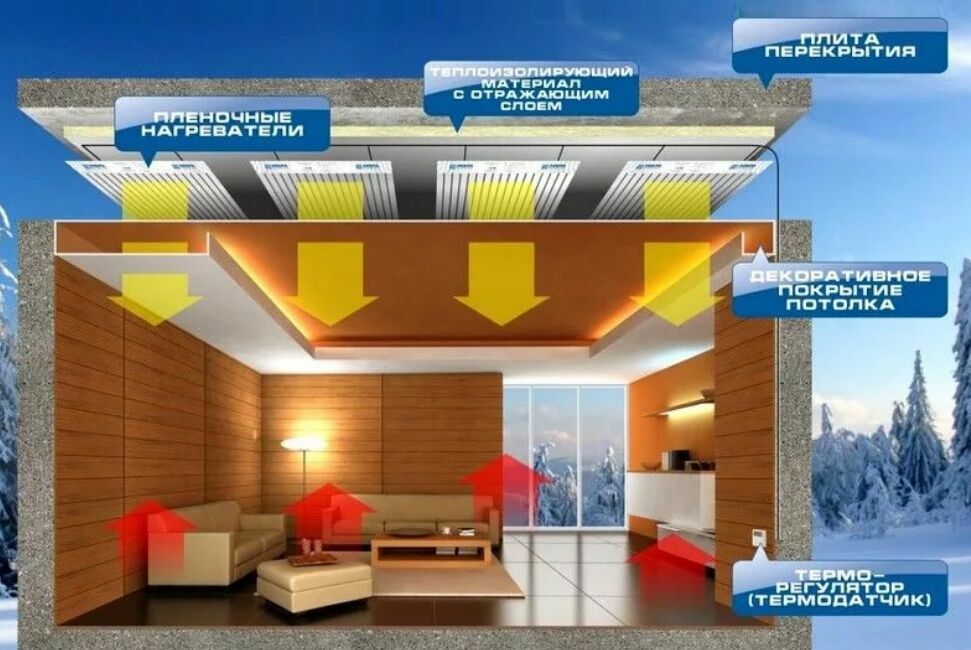
The most effective is the ceiling option, infrared rays from the ceiling cover the maximum possible area in the room
Infrared heating films are produced in the form of:
- models of given sizes (for example, "ZEBRA" or "NIRVANA");
- canvases for individual cutting according to design dimensions, they are produced in widths from 50 to 100 cm.
The first option cannot be cut at the installation site. Such systems are available in finished form, you just need to connect the wires with terminals. They must be especially thoughtfully selected from the size range available from the manufacturer so that the installation does not cause problems later.
The second version of the films is sold in rolls up to 7 meters long. This option infrared floor heating can be cut to the required dimensions directly in the room with ordinary scissors.
Advantages and disadvantages of film heaters
The advantages of heating IR films are as follows:
- High safety and reliability.
- Minimum terms of installation of system of electric heating.
- The fastest and most comfortable heating of the room for a person.
- Aesthetic view of the heating system, which is completely covered with decor.
- Full automation of the heater, as a result, no need for maintenance.
- High efficiency.
- Zero risk of water (coolant) leakage from the batteries.
- No problems with drying and burning out of oxygen in the room air.
- Absolute noiselessness of work.
- No convection - no dust settling everywhere.
- The ability to install in each room in the house its own microclimate in accordance with the specified parameters.
- The absence of sudden temperature changes in height (the difference near the floor and under the ceiling will be within 2–3 degrees).
The conductors and heating elements in the infrared heater are securely soldered in PAT film at the factory. Plus, there are no moving parts in such a heating system at all. Wear out, break down and corrode nothing.
In a house with an area of 100 square meters, the IR film system, along with wiring and protection in the electrical panel, is installed in 2-3 days. The main thing is that the network is designed for the required loads.
The electric heater is turned on/off thermostat, which monitors the temperature in the room using built-in sensors and supplies power to the heating elements itself. There are also programmable thermostats that allow you to set different modes for different rooms and times of day.
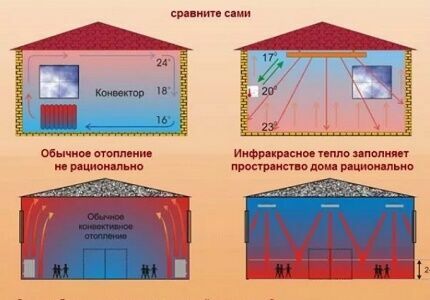
The high efficiency of using IR heaters is due to the short duration of their operation, they are turned on by the thermostat in general only for 10–20 minutes per hour
Of the minuses of film IR electric heaters, it is worth mentioning:
- Large electricity bills.
- The need for sufficient power to enter the mains into the house.
With the same area of a cottage or apartment, the cost of electricity will be 1.5–2 times higher than the cost of gas heating from the main system. But a gas boiler, its connection to a mains or gas tank and installation of batteries with pipes is also significant money.
Installation of a radiant heating system will cost several times cheaper than this option. And at solid fuel boilers it wins even more in terms of both fuel consumption and installation costs.
Features of installation of film infrared heating
Flexible film heaters can be easily mounted on your own with your own hands. The main thing during transportation and cutting is not to bend the film at an angle of more than 60 degrees. Its incision is made in the places indicated by the manufacturer on the canvas.
As a heater, it is best to put under the film isolon or penofol with an IR-reflecting foil layer. And the thermostat should be installed away from direct sunlight, batteries and drafts.
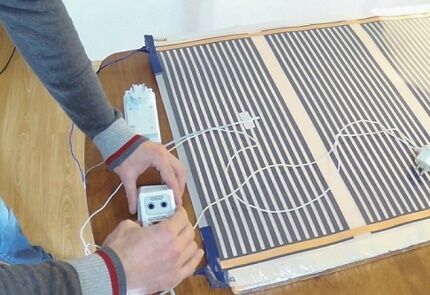
If you put a programmable thermostat, then it will be possible to heat different rooms in the house sequentially separately. This will significantly reduce the load peaks in terms of current and power at the input of the power grid to the cottage.
To achieve maximum effect, the area of the film heater should reach 60-70% of the square of the heated room. At the same time, IR film cannot be placed under furniture on the floor and above high cabinets under the ceiling. There will be zero sense for people from such heating, but points of local overheating in the room will appear.
Also, the strips of the infrared flexible electric heater must be moved away from the walls by 15–20 cm. In order to correctly calculate and lay out the film, it is necessary to draw up a plan of the room in advance with all the required indents and places for arranging furniture.
Any finishing material is a screen for infrared radiation. The only question is the degree of its transparency, the weakening of the IR rays and the heating of this finish or cladding. Some items of facing options let in radiant heat, while others less.
Option #1 - on the floor
The infrared IR heater in the floor version is laid on a flat rough base made of concrete, wood boards or drywall. It cannot be placed in a concrete screed or a layer of tile adhesive, polymer film not designed for alkaline attack from the cement used.
As a topcoat, it is permissible to lay on top:
- laminate (without cork backing);
- thin carpet over chipboard or plywood flooring;
- linoleum without heat-insulating sublayer.
It is not recommended to lay parquet on top of the IR film. The wood of parquet dice from overheating will crack and creak.

It is forbidden to place furniture with legs on top of the film heater, this can lead to its punching and damage, as well as cause local overheating of the floor covering.
By SanPiNam the floor in living rooms is only allowed to be heated up to +26 0FROM. However, in case of severe frost outside the IK window, the underfloor heating system will have to be turned on at full capacity in order to achieve comfortable indoor air temperatures.
And in this case, walking on it with bare feet will become uncomfortable. This is the main disadvantage of the floor version of infrared film heating.
Option #2 - on the ceiling
Film infrared heaters in the ceiling version are allowed to be closed:
- eurolining, MDF and GKL with thickness up to 12 mm;
- stretch ceilings (PVC or fabric);
- suspension systems such asArmstrong" or "Grilyato».
You can also use plastic panels, but only on condition that their manufacturer allows their decor to be heated up to +500FROM.
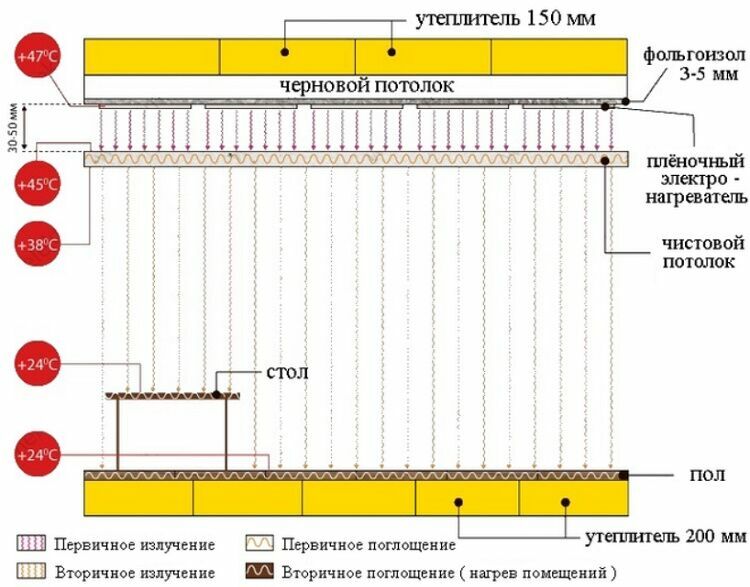
The closer to the infrared film the fine ceiling finish, the better. To the maximum, they can be moved away from each other only by 20 mm.
If the IR film heater is mounted together with a suspended ceiling, then the heating film should be laid directly on the system frame. It is impossible to fix it on the floor, as there will be too much air gap between PLEN and fine finish.
It is impossible to mount any metal, mirror and glass finishing structures on top of the infrared film. Also avoid using glass-magnesium panels.
Conclusions and useful video on the topic
Roller #1. About the advantages and installation of the ceiling PLEN:
Roller #2. Types of heating infrared films:
Roller #3. Pros and cons of infrared heating:
Infrared radiant heat in your home is an efficient and safe way to heat your home. The installation of electric IR films pays off within 2–3 years due to savings on solid fuel for boilers and the cost of boiler equipment.
Even with heating on gas from the main, the heaters in question win in the end. It is only necessary to correctly calculate them for a particular room and has sufficient specifications for the power of the power grid.
Do you want to talk about how you chose or installed a radiant film heating system with your own hands? Do you want to share technical nuances and technological subtleties that will be useful to site visitors? Please write comments in the block form below, ask questions, publish photos on the topic of the article.


